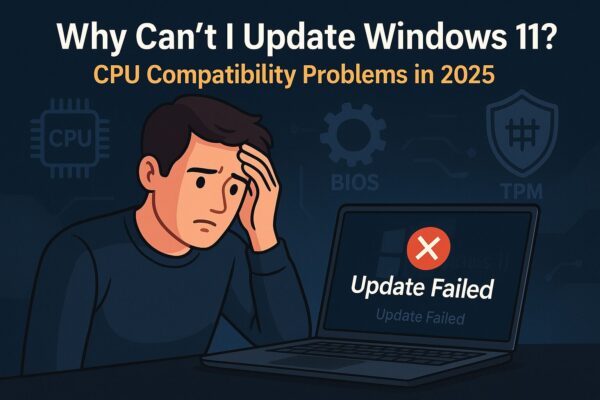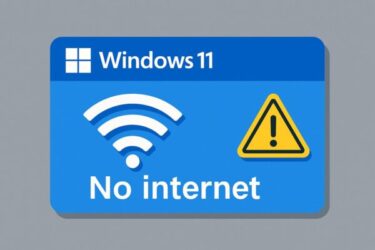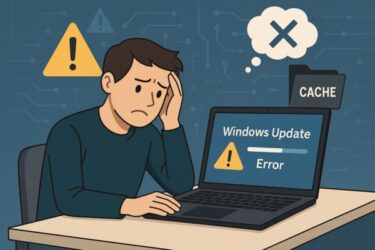
Last month, I saw a strange message on my Windows 11 Pro system:
“Your version of Windows has reached end of service.”
Wait, what!? I’m running Windows 11 Pro — and it’s fully updated!
Some users see messages like:
- “Your version of Windows has reached end of service.”
- “This PC doesn’t meet the minimum system requirements to install this version of Windows 11.”
What’s Going On? Why Can’t I Update Windows 11?
It turns out that more and more users are facing this issue: Windows 11 is installed, but the system won’t update to the latest version.
And in my case, the root cause was something unexpected: the CPU compatibility.
This article explains what caused the issue, how to check your system, and how to fix it — including the latest tips as of June 2025.
My Symptoms
- Windows Update says: “This device doesn’t meet the current system requirements.”
- Update attempts fail midway or don’t start at all.
- According to Microsoft: “Even supported devices may experience this under certain conditions.”
Fix 1: Run System File Repairs
If your Windows system files are corrupted, updates may fail.
Steps:
- Open Command Prompt as Administrator
- Run these commands one by one:
sfc /scannowDISM /Online /Cleanup-Image /RestoreHealth
In my case, this did not help.
Fix 2: Clear Windows Update Cache
Sometimes, cached update files cause failures.
Steps:
- Press
Windows + R→ typeservices.msc - Right-click Windows Update → Stop
- Go to
C:\Windows\SoftwareDistributionand delete all contents - Restart the Windows Update service
Still didn’t solve the issue for me.
Fix 3: Try Manual Upgrade
When automatic updates fail, you can manually apply the latest version.
- Visit Microsoft’s Windows 11 page
- Download “Installation Assistant”
- Follow the on-screen steps to update
But again… it failed.
So What Was the Real Cause?
Even though I’m using a Core i-series CPU, Microsoft has gradually increased hardware requirements — especially for new updates like 24H2.
- Older CPUs may no longer support new instruction sets
- Firmware or BIOS versions can also cause update blocks
This was the main reason in my case. So frustrating!
How to Check CPU Compatibility
- Press
Windows + R, typemsinfo32 - Check the “Processor” field
- Compare your CPU with the Microsoft CPU Compatibility List
Tools like WhyNotWin11 can also help check compatibility in one click.
Solutions (If It’s Really a CPU Compatibility Issue)
- Update BIOS/UEFI
Check your device manufacturer’s site for BIOS updates and apply them carefully. - Replace the CPU
If unsupported, you may need to upgrade the processor — but consult a professional. - Clean Install
Creating a bootable USB and reinstalling Windows 11 fresh sometimes solves deep compatibility issues.
⚠️ Backup your data before trying any major changes.
Unsupported CPUs (Not Recommended for 24H2)
- Intel: 7th Gen (e.g. Core i7-7700K)
- AMD: Ryzen 1000 series (e.g. Ryzen 5 1600)
Supported CPUs
- Intel: 8th Gen and newer (e.g. Core i5-8600K)
- AMD: Ryzen 2000 series and newer (e.g. Ryzen 7 2700X)
June 2025 Update: New Issues You Should Know
- KB5058405 / KB5062170 cause boot failures (ACPI.sys error 0xc0000098) especially on virtual machines
- Citrix users see rollback errors unless updated to version 2503+
- Recovery → “Uninstall updates” or manually applying KB5062170 from Update Catalog may fix the issue
Latest Troubleshooting Tips (June 2025)
- Check TPM 2.0 is enabled via
tpm.msc. BIOS setting may need to be adjusted. - Ensure Secure Boot is enabled and system is using GPT format
- Update all device drivers before retrying updates
- Try “in-place upgrade” using Installation Assistant (user files retained)
▶︎In-place upgrade means reinstalling Windows over the current system while keeping apps and files. It often helps when updates fail due to unknown corruption or misconfigurations.
- Make sure your battery is full and plugged in before BIOS update (for laptops)
Frequently Asked Questions
- Q: Why does Windows 11 say “end of service” even though I have the latest version?
A: It may be caused by hardware compatibility changes (CPU, TPM, BIOS) introduced in version 24H2. - Q: Can I still install updates on an unsupported CPU?
A: Technically yes, using unofficial tools like Rufus, but it’s not recommended for most users and may void support.
Useful Links
| Link | Description |
|---|---|
| Windows 11 Download Page | Manual update tools |
| PC Health Check Tool | Check if your PC supports Windows 11 24H2 |
| Microsoft Support | Official troubleshooting help |
Summary
If your PC can’t update to the latest Windows 11, check your CPU first — it might no longer be supported.
Use the steps above to diagnose the issue, and follow recommended actions carefully.
And remember: Always back up your data before trying advanced fixes!
✔️You might also find these helpful:


